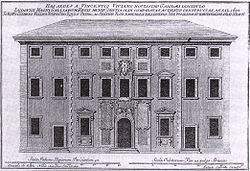
Palazzo dei Cartelloni
Encyclopedia

Florence
Florence is the capital city of the Italian region of Tuscany and of the province of Florence. It is the most populous city in Tuscany, with approximately 370,000 inhabitants, expanding to over 1.5 million in the metropolitan area....
, central Italy
Italy
Italy , officially the Italian Republic languages]] under the European Charter for Regional or Minority Languages. In each of these, Italy's official name is as follows:;;;;;;;;), is a unitary parliamentary republic in South-Central Europe. To the north it borders France, Switzerland, Austria and...
.
This building displays many unusual architectural elements, the most evident being the unusually big epigraphs written in Latin. The owner of the building, the mathematician Vincenzo Viviani
Vincenzo Viviani
Vincenzo Viviani was an Italian mathematician and scientist. He was a pupil of Torricelli and a disciple of Galileo.-Biography:...
, had them applied on the main façade in 1693, in order to celebrate and glorify the life and many discoveries of his master, Galileo Galilei
Galileo Galilei
Galileo Galilei , was an Italian physicist, mathematician, astronomer, and philosopher who played a major role in the Scientific Revolution. His achievements include improvements to the telescope and consequent astronomical observations and support for Copernicanism...
. It is after these inscriptions that the building takes its name.
The main architecture of the building was created by Giovan Battista Nelli, while the bust of Galileo that still stands over the main entrance was sculpted by Giovan Battista Foggini, and is actually a copy of the original made by Giovanni Caccini in 1610.
After Viviani died in 1703, the building was inherited by his nephew, the Abbot Paolo Panzanini. The palace was then acquired by Giovan Battista Nelli’s son, who had the same name as his father. The new owner took good care of the many books and manuscripts which belonged to Viviani, and also published the façade’s inscriptions in his work Galileo’s Life and Literary Commerce.
The palace was later owned by the Sermolli family (who then became the Picchi Sermolli family) and successively by the Loria family.
Today Palazzo dei Cartelloni is owned by SACI
SACI
SACI Studio Art Centers International, Florence, Italy, was founded by artist and director emeritus Jules Maidoff in Tuscany in 1975 and incorporated in 1976 as a U.S...
Studio Art Centers International, a U.S. non-profit educational institution teaching accredited Fine Arts courses to international students.
A small classical garden, which was recently restored, is located within the premises and includes a double staircase leading to an upper terrace.
The rooms inside the palace have been renovated several times throughout the centuries. Some of them have wonderful coffered ceilings, probably dating to the 19th century, and beautiful frescos. These frescos display typical themes of the time, such as romantic landscapes, grotesque
Grotesque
The word grotesque comes from the same Latin root as "Grotto", meaning a small cave or hollow. The original meaning was restricted to an extravagant style of Ancient Roman decorative art rediscovered and then copied in Rome at the end of the 15th century...
s and rustic scenes. On the first floor, a Trompe-l'œil fresco covers the entire room, giving the optical illusion of a pergola, with an olive tree in the distance.
Sources
- Sandra Carlini, Lara Mercanti, Giovanni Straffi, I Palazzi parte seconda. Arte e storia degli edifici civili di Firenze, Alinea, Florence, 2004.
External links
- Sito della Regione Toscana from which is taken the original Italian version with GFDL licensing (see the Italian version for license authorization).
- http://www.saci-florence.edu

